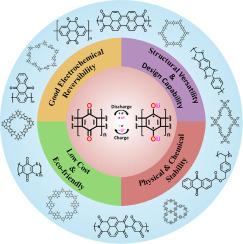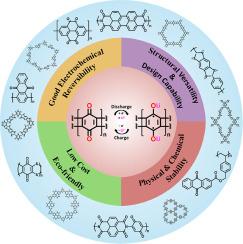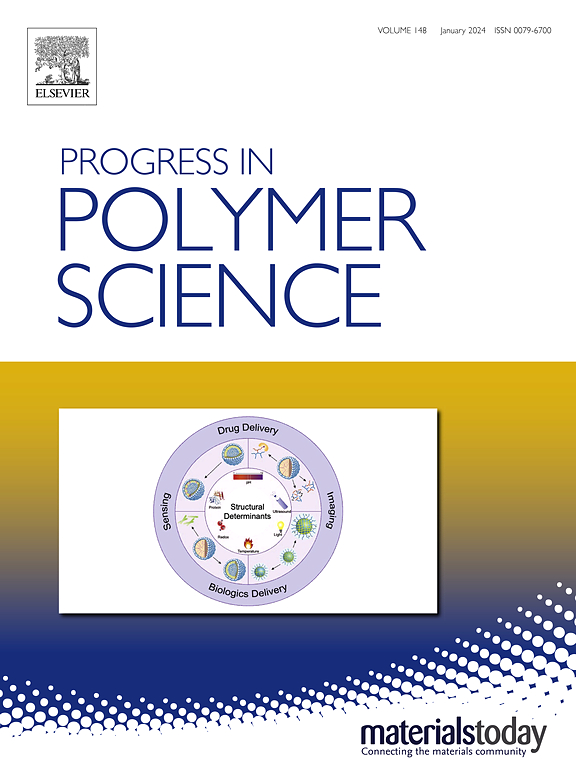Research progress on conjugated carbonyl polymer electrodes for organic lithium batteries
IF 26.1
1区 化学
Q1 POLYMER SCIENCE
引用次数: 0
Abstract
Conjugated carbonyl polymers (CCPs) have emerged as a promising class of organic electrode materials for high-performance organic lithium batteries, offering unique advantages such as structural versatility, tunable electrochemical properties, sustainability, and high theoretical capacity. These materials address key limitations of traditional inorganic electrodes, including resource scarcity and environmental concerns. Their conjugated π-systems enhance electron transport, and polymerised structures improve anti-dissolution and thermal stability. However, challenges such as low conductivity, limited carbonyl utilization, high synthesis costs, and compatibility issues with existing battery systems hinder their practical application. This review comprehensively summarizes the research progress of CCPs in organic lithium batteries, focusing on strategies to optimize their structure and performance through molecular engineering, morphology control, composite synthesis, and electrode fabrication. It analyzes the fundamental relationships between molecular structure, electrochemical performance, and practical applicability, highlighting advancements in enhancing conductivity, cycle stability, and rate capability. Furthermore, the review discusses current challenges, including cost reduction of synthesis, improvement of structural stability, and optimisation of interfaces, alongside potential solutions and future research directions. By integrating insights from computational simulations, experimental studies, and practical application considerations, this work underscores the potential of CCPs to advance next-generation high-energy-density, sustainable organic lithium batteries, paving the way for their broader adoption in energy storage technologies.


有机锂电池共轭羰基聚合物电极研究进展
共轭羰基聚合物(CCPs)已成为高性能有机锂电池的有机电极材料,具有结构通用性、电化学性能可调、可持续性和高理论容量等独特优势。这些材料解决了传统无机电极的主要局限性,包括资源稀缺和环境问题。它们的共轭π体系增强了电子传递,聚合结构提高了抗溶解性和热稳定性。然而,诸如低导电性、有限的羰基利用率、高合成成本以及与现有电池系统的兼容性问题等挑战阻碍了它们的实际应用。本文综述了CCPs在有机锂电池中的研究进展,重点介绍了从分子工程、形态控制、复合材料合成和电极制备等方面优化CCPs结构和性能的策略。它分析了分子结构、电化学性能和实际适用性之间的基本关系,重点介绍了在提高电导率、循环稳定性和速率能力方面的进展。此外,本文还讨论了当前面临的挑战,包括降低合成成本、提高结构稳定性和优化界面,以及潜在的解决方案和未来的研究方向。通过整合计算模拟、实验研究和实际应用考虑的见解,这项工作强调了ccp在推进下一代高能量密度、可持续有机锂电池方面的潜力,为其在储能技术中的广泛应用铺平了道路。
本文章由计算机程序翻译,如有差异,请以英文原文为准。
求助全文
约1分钟内获得全文
求助全文
来源期刊

Progress in Polymer Science
化学-高分子科学
CiteScore
48.70
自引率
1.10%
发文量
54
审稿时长
38 days
期刊介绍:
Progress in Polymer Science is a journal that publishes state-of-the-art overview articles in the field of polymer science and engineering. These articles are written by internationally recognized authorities in the discipline, making it a valuable resource for staying up-to-date with the latest developments in this rapidly growing field.
The journal serves as a link between original articles, innovations published in patents, and the most current knowledge of technology. It covers a wide range of topics within the traditional fields of polymer science, including chemistry, physics, and engineering involving polymers. Additionally, it explores interdisciplinary developing fields such as functional and specialty polymers, biomaterials, polymers in drug delivery, polymers in electronic applications, composites, conducting polymers, liquid crystalline materials, and the interphases between polymers and ceramics. The journal also highlights new fabrication techniques that are making significant contributions to the field.
The subject areas covered by Progress in Polymer Science include biomaterials, materials chemistry, organic chemistry, polymers and plastics, surfaces, coatings and films, and nanotechnology. The journal is indexed and abstracted in various databases, including Materials Science Citation Index, Chemical Abstracts, Engineering Index, Current Contents, FIZ Karlsruhe, Scopus, and INSPEC.
 求助内容:
求助内容: 应助结果提醒方式:
应助结果提醒方式:


